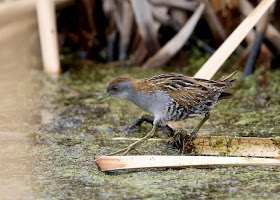Three of
Australia’s five resident crakes are found in Victoria including East Gippsland.
They are the Australian Spotted Crake (Porzana
fluminea), Spotless Crake (Zapornia
tabuensis) and Baillon’s Crake (Zapornia
pusilla). (1)
If you read
a number of bird guides regarding crake behaviour you will find descriptions
such as these: very small birds, inhabit dense wetland vegetation, extremely
elusive, secretive, wary, shy, unobtrusive, seldom leave dense cover, nervous,
high-strung, difficult to observe, chance of being observed by casual observer
slight, more often heard than seen, dash to cover when disturbed.
Unless you
target this species in their preferred habitats – for example wetlands dense with
vegetation such as Giant Rush (Juncas
ingens), Common Reed (Phragmites
australis) and Cumbungi (Typha
species) then in a life of birding you may never or rarely see a crake
unless by sheer luck. That said crakes can be relatively easy to find and
observe if you look in the right places (2) at the right time (early
mornings with no wind are probably the best times).
On a recent
BirdLife East Gippsland Monday morning outing to Macleod Morass on the
outskirts of Bairnsdale, myself and a few members found an Australian Spotted
Crake foraging in a small clear area of shallow water and exposed mud
surrounded by Phragmites and Cumbungi – ideal crake habitat. It was about
10.30am with no wind and an overcast sky – perfect conditions for crakes to
venture from the dense reeds into the open. Two of our small group had not seen
crakes before.
As we
watched the Spotted Crake, a Spotless Crake came out of the reeds and commenced
foraging. The excitement level increased with a second elusive crake species
now clearly visible to our small party. At this point two of our members now
had life ticks for two of Victoria’s three crake species. And then a Baillon’s
Crake emerged from the reeds and proceeded to move about in the open as it
foraged in the shallow water and mud. A third life tick for two very lucky
birders in one location within the space of 10 minutes or so and very good
views with plenty of time for close observation – simply amazing! It took me
years to finally tick these three elusive crakes and here all three species
were foraging right near us – a rare occurrence for sure.
As the
group enjoyed this very lucky encounter I kept busy trying to nail some photos
as the crakes appeared in small openings in the vegetation and slowed down
enough from their busy foraging.
The following
selection of photos from the crake encounter are arranged by species in the order
of their appearance.
Please click on photos
to enlarge.
The
Australian Spotted Crake from my experience is the most often seen crake in our
area and is probably the least shy crake – it can sometimes be found out
feeding in the open well away from cover.
The Spotless
Crake from my experience is probably the most shy or nervous crake. It is more reluctant
to come out into the open and often dashes for cover at the slightest provocation.
The Baillon’s
Crake is the smallest crake and in terms of its wariness (once again based on
my experience) falls somewhere between the Spotted and Spotless Crakes.
After about
15 minutes observing the three Victorian crake species – all with justified reputations
for being hard to find and observe - we returned to the main group for morning
tea knowing we had just been privileged to have enjoyed a rare birding experience.
NOTES
1. Regarding
the origin of the names crake and rail, Fraser & Gray have the following to
say:
The two key base names (crake and rail) go well
back to their British relations and did not arise in Australia. As might be
expected for such cryptic though widespread birds, both names are onomatopoeic.
The names
crake and rail are interchangeable, there being no taxonomic significance to
these names. Crake tends to be used for the smaller birds in the RALLIDAE
(crakes and rails) family.
2. Crakes
and rails can be nomadic and may migrate. The prolonged severe and widespread drought
in Australia at present may have resulted in an increase in crake species and
abundance in Macleod Morass which benefits from the managed input of treated
wastewater from the Bairnsdale wastewater treatment plant. Many local wetlands
and farm dams are either dry or have very low water levels at present. These
conditions may have increased our likelihood of finding three species of crake
in one location.
































